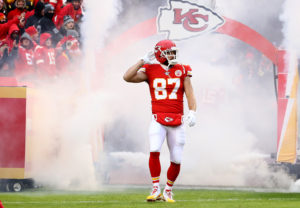
When To Draft Early Round Tight Ends in 2021
As we get closer to the peak of fantasy football draft season, everyone is going to be discussing varying draft strategies with the different advantages and disadvantages: Zero RB, RB Heavy, Late QB, WR/QB stacks, and many more… In this article, we take a look at an Early round tight ends draft strategy, and when it would be advantageous to draft one of the top tier TEs in this year’s fantasy draft, or when reaching for one may hurt your roster.
In recent years, the positional scarcity of the TE position has become extremely apparent. Similar to the Running Back position, each NFL team only starts one TE, with few even utilizing a second in a fantasy-related fashion. So if everyone in your league is reaching to load up on stud RBs and a top tier TE, do you have to do the same in order to compete? Or should you take advantage by drafting more WRs early? There were 70 different TEs that had at least one top-12 TE fantasy finish during the 2020 season, proving the significant inconsistency among the TE position. To help analyze these draft decisions, let’s take an individual look at the top TEs, by average draft position (ADP), for this year’s redraft season.
Travis Kelce

First up is Travis Kelce of the Kansas City Chiefs. Kelce is coming off not only one of the best TE fantasy seasons, but also one of his personal bests. In 15 games played, Kelce finished with 105 catches for 1,416 yards and found the endzone 11 times. For fantasy, this resulted in over 312 PPR fantasy points, or about 21 PPR fantasy points per game (FPPG). And according to current PPR ADP data, Kelce is being drafted in the mid/late first round with the 8th overall pick.
What might truly separate Kelce from other top-tier TEs has been his consistency. The TE position is one where touchdowns are highly correlated with weekly fantasy football finish, meaning that scoring a TD on any given week is highly likely to result in a top-10, if not top-6, weekly finish. For a perfect example, Mercedes Lewis turned in a top-9 fantasy finish last year during Week 3 – with only an 18-yard TD catch.
Given how touchdown dependent TE fantasy performance is (see the table below), it’s rare to find a player that’s consistently turning in TE1 finishes each week throughout the season.

The table above shows the percentage of games that resulted in a top-12 TE weekly finish, depending on whether the TE scored a TD. Without scoring a TD, TEs only finished as a top-12 TE 5.6 percent of the time. However, scoring at least one TD gave any TE a 81.2 percent probability of finishing that week as a starting TE1 (in 12-team formats). So with TE performance usually being TD-dependent, how consistent has Kelce been?
During the 2020 season, Kelce produced a top-12 TE fantasy finish in 14 of his 15 games played (93.3%). For comparison, Darren Waller was the closest to Kelce in consistency last year, finishing as a top-12 TE in only 68.8 percent of games played. And no, this wasn’t just one outlier year for Kelce. Over the last two seasons, Kelce has been a top-12 TE in 87.1 percent of his games played. Who was the closest to Kelce over the last two seasons? George Kittle, finishing as a top-12 TE at a 68.2 percent rate.
Kelce has been able to perform at such a high level due to the Chiefs high-powered offense, and specifically his involvement in that offense. The Chiefs have been a top scoring offense over the last two years, scoring 28.5 points per game (PPG) last year and 29.9 PPG in 2019 – which ranked 6th and 2nd in the NFL, respectively. Not only are the Chiefs often near the endzone, but Kelce has been a big piece of the red zone offense in Kansas City. Last year, Kelce received 23 red zone targets, and we should feel confident in his ability to replicate those numbers again this year, given how prolific the Chiefs offense continues to be.
Kelce’s overall production of 20-plus FPPG (in PPR formats), combined with his unparalleled consistency at the TE position, puts him in a tier of his own at TE. Drafting Kelce at his current ADP – 8th overall according to Underdog Fantasy – might be a bit of a stretch for me, given the potential tier of RBs that you could be missing out on. For example, drafting Kelce at 1.08 means that your earliest possible RB selection would be made at 2.05 (17th overall pick), likely with someone like Najee Harris or Antonio Gibson… maybe Joe Mixon. However, if your draft position is a bit closer to the turn, around the 10th or 11th pick, I would be happy to start my draft with a difference maker like Kelce at TE, then scooping up a top-12 ranked RB like Austin Ekeler or Nick Chubb.
Darren Waller

Next, let’s take a look at Darren Waller of the Las Vegas Raiders. Last year, in 16 games played, Waller compiled 107 catches for 1,196 yards and 9 touchdowns. In terms of fantasy production, this equated to over 278 PPR fantasy points, or about 17.4 PPR FPPG. And according to current PPR ADP data, Waller is coming off the board at the end of the second round with the 22nd overall pick.
If we were to compare Waller to all other TEs, last year Waller outperformed all other TEs in the following categories:
- Target Share – percentage of the team’s total targets: 27.7%
- Reception Share – percentage of the team’s total receptions: 29.0%
- Red Zone Targets – total targets within the 20-yard line: 24
Waller is clearly one of the most used TEs in any offense in the NFL. In fact, last year the Raiders led in NFL TE usage, with 33 percent of all targets going to a TE. Combine this with the departure of Nelson Agholor, the team’s leading receiver from last year, and 120 total vacated targets, and the usage for Waller this upcoming season shows no signs of tapering off. As a quick side note: Over 14 percent of those vacated targets were already TE targets (Jason Witten).
Let’s quickly compare Waller to a couple other pass catchers from last season. Given the Red Zone statistics below, think about which performance would be most easily replicated in the upcoming season:

Many other analysts and writers in the community have shown how difficult it can be to replicate high-scoring TD seasons. However, we see that despite his Red Zone usage, Waller happened to find the end zone less often (31.6% of RZ catches) than Player A (60.9%) and Player B (71.4%), both who had similar red zone usage as pass catchers.
We can also see that this isn’t due to drops, because Waller had a far better Red Zone Catch % than Player B and was only six percent (essentially one reception) behind Player A. Assuming that Waller remains an integral part of the Raiders’ red zone offense, there’s no reason to believe he won’t produce at least similar, if not improved, TD numbers this season. On the other hand, it would be more difficult for Player A and Player B to repeat last year’s performance, but both Davante Adams (Player A) and Travis Kelce (Player B) are being drafted well before Waller right now.
To further assess Waller’s current ADP, let’s temporarily ignore the TE position tag. With 17.4 PPR FPPG, Waller would have finished as the 7th best WR last year, right behind Keenan Allen who finished with 17.5 PPR FPPG. That puts Waller above WRs like Justin Jefferson, AJ Brown, and DK Metcalf. All of these WRs are also being drafted around the end of the second round / early third round, so from a fantasy point production standpoint, Waller’s current ADP seems to make sense. Once we add in the TE designation and realize the positional advantage that Waller provides, we should willingly start to target Waller towards the end of the 2nd round.
Be on the lookout for a follow-up article, as we take a look at two more top TE options and their ADP!






